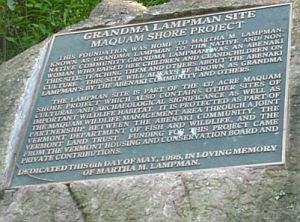
(HOST) All this week, VPR has been observing Women’s History Month
– and the Champlain quadricentennial – by honoring Vermont
women who contributed to the history and culture of the Champlain
Valley. Louise Lampman-Larivee is the greatgranddaughter of the Abenaki woman from
Swanton known as Grandma Lampman, who was known for her knowledge of tribal customs and medicinal herbs.
(LAMPMAN-LARIVEE) Missisquoi, or Mazipskoik ("place of flint") has long
been a central gathering place for Abenaki families. This ancient Abenaki
village is located on the northeast shore
of Betowbagw ("the lake
between"), or Lake Champlain, where the Missisquoi
River flows into one of the largest
bodies of water in New England. When colonial settlement
took hold in northern Vermont,
many of the Missisquoi families remained or retreated into the marshes of the
delta, where they lived according to the cycles of subsistence, well into the
twentieth century.
The community leader and healer Martha Morits was born into
an old Missisquoi family, married John Lampman, a man from another Abenaki
leadership line, and built a small house and barn in the marsh during the
late1800’s. Families would come together
in this area known as Maquam (named for the active beavers that share this
environment) to fish the Bay in the spring, to gather berries and medicinal
plants during summer, and to hunt and trap the abundant game animals in the
fall and winter. Often, they would camp
the whole summer there, making trips into the village to sell their surplus
gatherings.
Always, there was dancing, singing, and storytelling at
Grandma Lampman’s. Here, families were
sustained. Far into the twentieth century, the Lampmans and their relations
lived in and around the marsh, learning and living from the bountiful resources
of Maquam.
In the mid-20th century, life in the Missisquoi
marshes was impacted dramatically by the establishment of the Missisquoi
Wildlife Refuge, which forced many of Grandma Lampman’s
descendants and relations from their homes. While families continued to hunt,
fish, and gather in the Refuge, they were no longer allowed to live there.
Meanwhile, families’ reliance on the area known as "Grandma
Lampman’s" increased, as development along the lakeshore took hold. In the
1990’s, when a developer threatened to turn Maquam into a housing complex,
Grandma Lampman’s great-grandchildren fought back, asserting their claims to
this place as a critical habitat for cultural survival and subsistence. After a
long battle in the administrative bureaucracy of the state, the courts, and in
the public, Grandma Lampman’s was protected and the Lampman family was
recognized as its primary caretakers.
My name is Louise Lampman Larivee. I am the daughter of Chief
Leonard Lampman
and the great granddaughter of Martha
Lampman, who was known as Grandma
Lampman to the Abenaki community.
Grandmother Martha was an Abenaki Herbalist and Medicine-woman who lived on the
ancient village of Missisquoi.
She raised her children and grandchildren on this land. This area of Missisquoi
was always known for the Native values that were taught to the children from
one generation to the next. It was and still is deer hunting and herb
gathering, and berry picking area for the Abenaki community.
Protecting this land was important, for the land was sacred
and spiritual to my family and others.
It took three years to
protect this site, from a local to a federal level, but in the end there sits a
plaque in memory of one very special Abenaki woman.
(Audio unavailable)
Click here to learn more about the role of women in Vermont History
Click here to learn more about this year’s celebration of the Champlain Quadricentennial